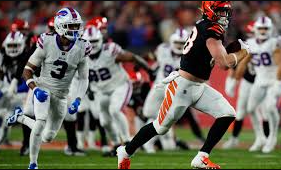
The dangers of American football persist despite awareness, with racial and class disparities playing a role in the sport’s controversial impact.
In the aftermath of Damar Hamlin’s terrifying collapse on the field during a game between the Buffalo Bills and Cincinnati Bengals, the football world has been forced to confront a painful reality. The 24-year-old player, after a hard tackle, stood up seemingly fine, but collapsed moments later, requiring medical staff to restart his heart before being rushed to hospital. As fans and players alike sent messages of support, the question remains: What will change following this shocking incident?
The truth is, American football – particularly its high-impact, aggressive style – is a violent sport. While fans are drawn to its thrilling, intense collisions, these very elements contribute to its dangers. Tackles, sacks, and brutal hits are intrinsic to the game’s appeal, but also its risks. Sports journalist Jeffri Chadiha described the sport as “built on violence,” a sentiment echoed by many, given the nature of the game.
The dangers of football have long been known. In the early 2000s, Dr. Bennet Omalu discovered chronic traumatic encephalopathy (CTE) in former Steelers player Mike Webster, a disease linked to brain trauma. Research has since revealed that the vast majority of former NFL players suffer from CTE, a devastating condition that causes mood swings, depression, and cognitive decline.
Despite these warnings, the NFL has been slow to address the dangers. Minor changes have been made, such as removing players from the field for concussion evaluation and banning certain hits. But these steps are largely seen as insufficient. The reality is that the sport continues to thrive on its violent nature, with little meaningful change.
Moreover, there are troubling racial and class elements at play. Football has often been seen as a pathway to success for disadvantaged young people, particularly those from lower-income or minority backgrounds. Yet, many middle-class families are now opting for safer sports like soccer, leaving American football increasingly tied to race and class.
A more disturbing aspect emerged in 2013, when the NFL reached a deal to compensate retired players suffering from brain damage. For years, the league used “race-norming” to argue that Black players had lower cognitive function, making it harder for them to qualify for compensation. It wasn’t until 2021 that the NFL finally ceased this practice.
Despite the growing evidence of harm, the NFL continues to thrive, with millions tuning in to games every week. The sport is estimated to be worth over $100 billion, and the Super Bowl has become a national spectacle. The question now is: Do we, as fans, continue to be complicit in this cycle of violence, or can we push for meaningful change to protect the athletes we watch and admire?
While some argue that changes could be made – such as eliminating kick-offs, which often result in pile-ups – the NFL seems reluctant to implement real safety measures. The case of Miami Dolphins quarterback Tua Tagovailoa, who suffered multiple head injuries in a short period, highlights the need for independent medical oversight in decision-making.
The time has come for us to ask ourselves: Can we continue to enjoy this violent spectacle at the cost of the players’ safety, or will we demand reforms to ensure a safer, fairer sport?












